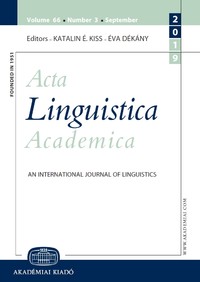Looking for the Kennformen of the Italian verb paradigm. An experimental study
Looking for the Kennformen of the Italian verb paradigm. An experimental study
Author(s): Pier Marco Bertinetto, Chiara Finocchiaro, Clara RastelliSubject(s): Lexis
Published by: Akadémiai Kiadó
Keywords: lexical access; Kennform(en); citation-form; morphological complexity; verb paradigm; Italian
Summary/Abstract: It is generally assumed that, within an inflectional paradigm, some forms are cognitively more salient than others. Although this effect is the result of various concomitant factors to which all forms of the given paradigm concur, the existence of salient forms is crucial to assist the speaker in predicting the remaining forms of the paradigm. The notion of ‘salient form(s)’ was implicit in the so-called Kennform(en) proposed by Wolfgang Ullrich Wurzel as inflectional class marker(s). A possible candidate to salience is the so-called citation-form, i.e. the form by means of which lexemes are referred to in a dictionary, but this should be checked on a language-by-language basis. The present paper addresses the task of defining the most salient form(s) within the Italian verb paradigm. By means of three lexical decision experiments, the performance on the Infinitive (the citation-form) was compared with the performance on its most likely competitors, i.e. the Present Indicative 3SG, which is the most frequent form of most verbs, and the Present Indicative 1SG, which is selected as citation-form in some lexicographic traditions. The results indicate that the Infinitive and the Present Indicative 3SG prevail over the Present Indicative 1SG – as well as on various other forms used as controls and fillers in the experiments – but do not differ from each other. This offers an interesting insight into the organization of a complex verb paradigm, such as the Italian one. In particular, it shows that salience depends on the interaction of various morphological and psycholinguistic factors, whose relative weight is a function of the specific language considered.
- Issue Year: 67/2020
- Issue No: 2
- Page Range: 219-246
- Page Count: 28
- Language: English
- Content File-PDF

